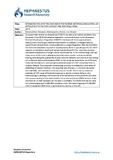| dc.contributor.author | Barone-Adesi, Giovanni | |
| dc.contributor.author | Giannopoulos, Kostas | |
| dc.contributor.author | Les, Vosper | |
| dc.date.accessioned | 2015-12-08T14:25:16Z | |
| dc.date.available | 2015-12-08T14:25:16Z | |
| dc.date.issued | 2015 | |
| dc.identifier.uri | http://hdl.handle.net/11728/6411 | |
| dc.description.abstract | To ensure that central counterparties (“CCPs”) are safe in all market conditions the European Union (EU) has adopted legislation, commonly known as the European Market Infrastructure Regulation (“EMIR”) that deal with their organisational requirements including prudential requirements in relations to margins and the waterfall and default funds. It has published in a single Regulation (EU) No 153/2013, the technical standards required to be adopted by all CCPs operating in the EU. EMIR requires a mandatory clearing of certain standardised OTC (i.e. over-the-counter) derivatives transactions through central counterparties. A risk methodology that can meet some of the most challenging technical requirements, such as sensitivity testing, estimating the probability of joint member defaults and reverse stress testing is the Filtered Historical Simulation (FHS). In this study we extend the use of Filtered Historical Simulation in estimating the potential losses the CCP would face from a multiple default. The proposed methodology provides a probabilistic estimation of defaulting of named members, the expected size of losses, i.e. the joint expected shortfall (JES), and confidence intervals around the JES. This in turn provides an estimate of CCPs need of financial resources to absorb multiple defaults. Our methodology is carrying a full re-pricing of all instruments in the portfolio and takes into account positions that expire before the profits and losses (P&L) horizon. Order statistics tell us that estimates on the tails is unreliable. To handle this risk we carry out a bootstrapping of 5,000,000 simulation trials. The bootstrapping of 5,000,000 trials is repeated 5,000 times to generated the density of the JES. | en_UK |
| dc.language.iso | en | en_UK |
| dc.publisher | Geneva :Swiss Finance Institute | en_UK |
| dc.relation.ispartofseries | Research paper series / Swiss Finance Institute;15,12 | |
| dc.rights | © 2015 Social Science Electronic Publishing, Inc. | en_UK |
| dc.rights.uri | http://creativecommons.org/licenses/by-nc-nd/4.0/ | en_UK |
| dc.subject | Central counterparty risk management | en_UK |
| dc.subject | Filtered historical simulation | en_UK |
| dc.subject | Stress testing | en_UK |
| dc.subject | Tail dependenc | en_UK |
| dc.title | Estimating the Joint Tail Risk Under the Filtered Historical Simulation. An Application to the CCP's Default and Waterfall Fund | en_UK |
| dc.type | Article | en_UK |
| dc.doi | 10.2139/ssrn.2588573 | |


